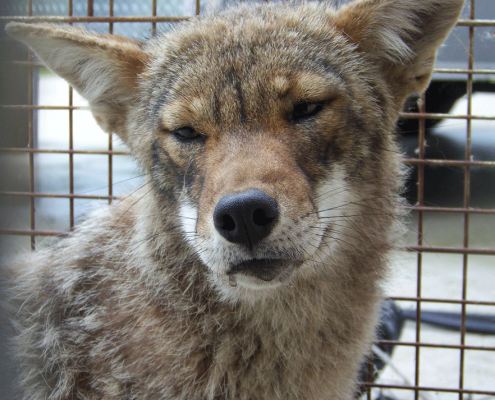
Coyote Solutions
Coyote Description
The coyote (Canis latrans) is a species of a medium-sized canine relative to North America and closely related to wolves. Their fur color is predominantly light gray and red and interspersed with black and white. Young pups are much darker, and usually more uniform in color, unlike adults. The color, as in many animals, varies somewhat with geography. These creatures come in a wide variety of shapes and sizes, and there are about 19 different subspecies recognized.
Coyote males weigh around 18 to 44 lbs. while females range from 15 to 40 lbs. They are smaller than wolves and their sizes vary geographically, as do most animals. Northern subspecies tend to grow larger than the Southern subspecies of Mexico. Their body length ranges on average from 3 ft. 3 inches to 4 ft. 5 inches, and tail length 16 inches, with females being shorter both in body length and height. Coyote sweat glands are located at the upper side of the base of the tail and are bluish-black in color. They have pointed ears and a long, narrow muzzle. Their noses are black, eyes are yellow, and their tails are long and bushy. They run with their tails down unlike dogs and wolves.
All canine tracks, from coyote and wolf to even dogs, share the same basic characteristics. Coyote paw prints are more oval than dog tracks. This is because they are often longer than they are wide. They have four toes and a roughly triangular-shaped heel pad. According to the University of Illinois Extension website, coyotes make slightly larger heel impressions than dogs. Their negative space, which is the space between the toes and heel pad, is much larger than dogs as well. In general, a coyote’s front paw-print measures approximately 2 ½ inches long and 2 inches wide. The hind paw-print is approximately 2 ¼ inches long and 1 ¾ inch wide. The footpads are smaller in the back prints.
The toes of these animals are tight and aerodynamic, meaning they have a shape that reduces drag when moving through the air. Their toes register deeper than their palm pad due to the coyote’s fitness and alertness. Their claws register as sharp and small, less prominent, and overall more compact. Their trails are direct and business-like unlike the dog’s meandering and playful ones. They have fairly crisp direct-register where the hind track lands on top of the front track. Coyotes use a variety of gaits, their most favored being an overstep trot. This is where the front and hind feet on the same side of the body land close together with the hind landing slightly ahead of the front. These leave a line of tracks that is very straight and narrow. When using a trot, step lengths between groups of tracks measure from 15 to 22 inches.
Coyote droppings, also called scats, are rope-like and typically filled with hair and bones. These animals use scat to communicate therefore they usually deposit them in the middle of trails or near borders of their territories. This is done to ensure that their droppings are clearly visible to other animals. Scat can provide information on their genetics, health, and diet but can be difficult to sample and usually non-specific to individual animals if found randomly in the field. Coyote scats vary in size, although on average they measure between three to four inches long, are tapered at the end, and are around one inch in diameter. The color and consistency of the scat is dependent upon the diet of these animals. Those that mainly feed on livestock and other small animals tend to produce dark, soft scat that contains fur and bones. Those that consume lots of fruit produce crumbly droppings that are lighter in color. The droppings turn grey when bleached by the sun.
Coyotes may advertise the occupancy of a particular territory to other coyotes by group howling. Some groups howl frequently whereas others rarely howl. These animals have a range of vocalizations depending on social context and message. Philip N. Lehner, in 1978, published his research on coyote communication and the meanings of the various vocalizations. In the book Coyotes: Biology, Behavior and Management, his research suggests that: The vocal repertoire of the adult coyote contains eleven vocalizations, several of which are also produced by pups.
Types of coyote vocalizations include:
- Growl
This is used as a threat, specifically for something within close range. - Huff
This is the release of air through the nose and mouth and is also used as a threat in close proximity. - Woof
It is made as both a low-intensity threat and as an alarm when a coyote is startled and unsure of what exactly is happening but is uncomfortable with it. - Group Yip-Howl
This is produced when coyotes reunite, or just before they separate to go off hunting individually. When more coyotes join in, the intensity of the vocalizations increase in frequency and amplitude. According to coyote researcher, Lehner, the group yip-howl strengthens social bonds, may help to synchronize mood, and may reaffirm social status within the pack. It reveals or hides how many coyotes are in the area and may help regulate coyote density through the reproductive rate.
The coyote is highly versatile in its choice of food, but is mainly carnivorous, with meat consisting of 90% of its diet. They feed on prey such as carrion, sheep, deer, rodents, birds, amphibians, turtles, crustaceans, and insects among others. Although coyotes are predators, they are also opportunistic feeders and shift their diets to take advantage of the most available prey. They generally feed on small prey but can shift to large prey occasionally. Although they prefer fresh meat, coyotes will scavenge when the opportunity presents itself. They require an estimated 1.3 lb. of food daily which may include a variety of produce such as blackberries, peaches, apples, peanuts, and cantaloupes among others.
- Heartworm: The Cook County Coyote Study found that 41% of the coyotes they tested were infected with heartworm. These worms cause inflammation of blood vessels and can block blood flow, leading to pulmonary thrombosis and heart failure.
- Sarcoptic Mange: This is a debilitating disease transmitted by a mite that is associated with coyotes and foxes. It infests animals by burrowing under their skin resulting in hair loss and increasing the animals’ susceptibility to other infections.
- Hydatid Disease: Echinococcus Granulosus is a tapeworm that can be passed to humans and animals. Coyotes serve as a host to this worm. The CDC lists this as a life-threatening disease in humans. You may not know that you are infected for up to 10 or 20 years. It causes cysts in the liver, lungs, and other organs, which eventually rupture and may lead to death.
- Canine Rabies: This is an acute viral illness of the animal’s central nervous system. The infection is transmitted when one infected animal bites another. They can also be spread via scratching, making it even more easily transmittable to humans or pets.
